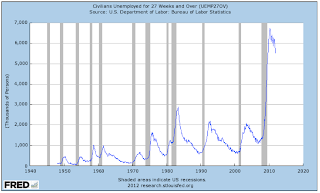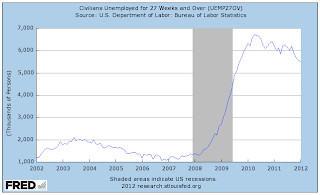
 While January’s unemployment data had both the markets and market pundits singing the economic recovery song, other employment statistics show that joblessness in America is not a thing of the past, in fact, these statistics show that long-term joblessness has reached levels not seen either during a recession or during the post-recession recovery since the 1940s.
While January’s unemployment data had both the markets and market pundits singing the economic recovery song, other employment statistics show that joblessness in America is not a thing of the past, in fact, these statistics show that long-term joblessness has reached levels not seen either during a recession or during the post-recession recovery since the 1940s.Here is a six-decade long graph from the St. Louis Federal Reserve Bank (FRED) showing where the problem lies:
Here is a close-up showing the same data for the past 10 years:
These graphs show the number (in millions) of civilians who have been out of work for 27 weeks or longer with the first graph showing the data between January 1948 and January 2012 and the second graph showing the data between January 2002 and January 2012. From the first graph, one can quite quickly see that the number of long-term unemployed has skyrocketed past the level experienced during and after any recent recession. This is particularly evident when looking at data from the past 10 years. The number of long-term unemployed reached a decade-long low of 1.078 million in October of 2006. By August of 2008, the number had risen to 1.864 million and ramped up very rapidly to hit a peak of 6.73 million by April 2010 (according to the NBER, the Great Recession began in December 2007 and ended in June 2009). The number of long-term unemployed has since fallen by only 18 percent over a 21 month period to 5.519 million, despite the fact that the economy is nearly three years past the end of the Great Recession. This level is well above the number of long-term unemployed throughout the past 10 years and still sits at a level that is 2.5 times higher than the level it peaked at after the recession of 2001 when it reached 2.1 million. In most of the previous 20th century recessions, the level of long-term unemployed dropped to half of the peak within 18 to 24 months, for example, the recession in the early 1980’s saw long-term unemployment peak in May and June of 1983; this had fallen to less than 50 percent of its peak by January of 1985. The fall in long-term unemployment after the recession of the early 1990’s was more drawn out, however, within 24 months of its peak in October 1992, it had dropped by 32 percent, a far better performance than what we are seeing in the post-Great Recession “recovery”.
Here is an interesting graph from a publication entitled "Five Long-Term Unemployment Questions" by the Pew Charitable Trusts:
Please note that Pew’s analysis defines long-term unemployed Americans as those who have been unemployed for more than 52 weeks. Pew’s analysis of the data from the fourth quarter of 2011 reveals that 4 million jobless workers were without work for more than one year, representing 31.3 percent of the U-3 unemployed and 2.6 percent of the total workforce. While the graph shows that the number of long-term unemployed has dropped from its peaks (as we saw in the FRED graphs above), the number of long-term unemployed (in dark green) is much higher than any previous recession going all the way back to World War II. Oddly enough, while older workers were less likely to experience joblessness, they are most likely to have been jobless for a year or more as shown here:
While the U-3 headline jobless numbers are finally showing glimmers of life, the data in this posting shows that the employment recovery is hardly breathtaking. What is particularly concerning is that the U.S. could well be entering the next recession with a record-breaking level of long-term unemployed. While America’s politicians squabble like school children over their partisan viewpoints on the debt and deficit, "Rome" is burning and "Nero" is, at best, paying lip service to the employment problems facing millions of American families. I only wish that I knew how to solve the problem.
Click HERE to read more of Glen Asher’s columns.
Article viewed on Oye! Times at www.oyetimes.com
You can publish this article on your website as long as you provide a link back to this page.





Be the first to comment